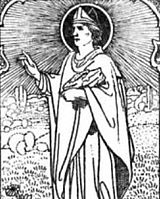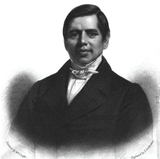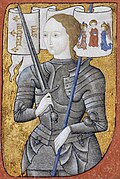
Back بوابة:المسيحية/شخصية مختارة Arabic Portál:Křesťanství/OSOBNOST Czech باب:مسیحیت/منتخب سوانح Urdu
| This Wikipedia page has been superseded by Portal:Christianity and is retained primarily for historical reference. |
| Note: Article entries are now being transcluded directly on the main portal page. However, this page should be retained for historical reference. |
The following selected biographies appear on Portal:Christianity. The layout for new additions is at Portal:Christianity/Selected biography/Layout.
- Current number of selected biographies: 15. (Update this number if you add more random biographies.)
|
Portal:Christianity/Selected biography/1 Justus (occasionally Iustus) (died on 10 November between 627 and 631) was the fourth Archbishop of Canterbury. He was sent from Italy to England by Pope Gregory the Great, on a mission to convert the Anglo-Saxons, probably arriving with the second group of missionaries despatched in 601. Justus became the first Bishop of Rochester in 604, and attended a church council in Paris in 614. Following the death of King Æthelberht of Kent in 616, Justus was forced to flee to Gaul, but was reinstated in his diocese the following year. In 624 Justus became Archbishop of Canterbury, overseeing the despatch of missionaries to Northumbria. After his death he was revered as a saint, and had a shrine in St Augustine's Abbey, Canterbury.Portal:Christianity/Selected biography/2 Huldrych Zwingli (1 January 1484 – 11 October 1531) was a leader of the Reformation in Switzerland. Born during a time of emerging Swiss patriotism and increasing criticism of the Swiss mercenary system, he attended the University of Vienna and the University of Basel, a scholarly centre of humanism. He continued his studies while he served as a pastor in Glarus and later in Einsiedeln where he was influenced by the writings of Erasmus. In 1518, Zwingli became the pastor of the Grossmünster in Zurich where he began to preach ideas on reforming the Catholic Church. In his first public controversy in 1522, he attacked the custom of fasting during Lent. In his publications, he noted corruption in the ecclesiastical hierarchy, promoted clerical marriage, and attacked the use of images in places of worship. In 1525, Zwingli introduced a new communion liturgy to replace the mass. Zwingli also clashed with the Anabaptists, which resulted in their persecution. The Reformation spread to other parts of the Swiss Confederation, but several cantons resisted, preferring to remain Catholic. Zwingli formed an alliance of Reformed cantons which divided the Confederation along religious lines. In 1529, a war between the two sides was averted at the last moment. Meanwhile, Zwingli’s ideas came to the attention of Martin Luther and other reformers. They met at the Marburg Colloquy and although they agreed on many points of doctrine, they could not reach an accord on the doctrine of the presence of Christ in the eucharist. In 1531 Zwingli’s alliance applied an unsuccessful food blockade on the Catholic cantons. The cantons responded with an attack at a moment when Zurich was badly prepared. Zwingli was killed in battle at the age of 47. His legacy lives on in the confessions, liturgy, and church orders of the Reformed churches of today.Portal:Christianity/Selected biography/3 Gregory of Nazianzus was a 4th century Christian bishop of Constantinople. He is widely considered the most accomplished rhetorical stylist of the patristic age. As a classically trained speaker and philosopher he infused Hellenism into the early church, establishing the paradigm of Byzantine theologians and church officials. Gregory made a significant impact on the shape of Trinitarian theology among both Greek-speaking and Latin-speaking theologians, and he is remembered as the "Trinitarian Theologian". Much of his theological work continues to influence modern theologians, especially in regard to the relationship among the three persons of the Trinity. Along with two brothers, Basil the Great and Gregory of Nyssa, he is known as one of the Cappadocian Fathers. Gregory is honored as a saint in both Eastern and Western Christianity. In the Roman Catholic Church he is among the Doctors of the Church; in Eastern Orthodoxy and the Eastern Catholic Churches he is revered as one of the Three Holy Hierarchs along with Basil of Caesarea and John Chrysostom.Portal:Christianity/Selected biography/4 Portal:Christianity/Selected biography/5 Ælfheah (954 – 19 April 1012; Old English: Ælfhēah, "elf-high"), officially remembered by the name Alphege within the Church, and sometimes called Alfege, was an Anglo-Saxon Bishop of Winchester, later Archbishop of Canterbury. He became an anchorite before being elected abbot of Bath Abbey. His perceived piety and sanctity led to his promotion to the episcopate, and eventually to his becoming archbishop. Ælfheah furthered the cult of St Dunstan and also encouraged learning. He was captured by Viking raiders in 1011 and killed by them the following year, after refusing to allow himself to be ransomed. Ælfheah was canonized as a saint in 1078. Saint Thomas Becket, a later Archbishop of Canterbury, prayed to him just before his own slaying in Canterbury Cathedral.Portal:Christianity/Selected biography/6 Nigel (c. 1100 – 1169) (sometimes Nigel Poor or Nigel of Ely) was an Anglo-Norman bishop of Ely. He came from an ecclesiastical family; his uncle Roger of Salisbury was a bishop and government minister for King Henry I, and other relatives also held offices in the English Church and government. Nigel owed his advancement to his uncle, as did Nigel's probable brother Alexander, who like Nigel was advanced to episcopal status. Nigel was educated on the continent before becoming a royal administrator. He served as Treasurer of England under King Henry I of England, before being appointed to the see, or bishopric, of Ely in 1133. Following the accession of Henry I's successor, King Stephen, Nigel remained as treasurer only briefly before his family was ousted from political office by the new king. Nigel rebelled and deserted to Stephen's rival Matilda, but eventually reconciled with Stephen. On the king's death, Nigel was returned to the treasurership by the new king, Henry II. Nigel's second tenure as treasurer saw him return the administration to the practices of Henry I. Most historians, then and now, have felt that Nigel's administrative abilities were excellent; he is considered to have been more talented as an administrator than as a religious figure.Portal:Christianity/Selected biography/7 Portal:Christianity/Selected biography/8 Peter Jones (missionary) (January 1, 1802 – June 29, 1856) was an Ojibwa Methodist minister, translator, chief and author from Burlington Heights, Upper Canada. His Ojibwa name was Kahkewāquonāby (Gakiiwegwanebi in the Fiero spelling), which means "[Sacred] Waving Feathers." In Mohawk, he was called Desagondensta, meaning "he stands people on their feet." In his youth his band of Mississaugas had been on the verge of destruction. As a preacher and a chieftain, as a role model and as a liaison to governments, his leadership helped his people survive contact with Europeans. As a bilingual and bicultural preacher, he enabled the Methodists to make significant inroads with the Mississaugas and Iroquois of Upper Canada, both by translating hymns and biblical texts in Ojibwe and Mohawk and by preaching to Indians who did not understand English. Jones was also a political leader. This brought him into contact with Superintendent of the Indian Department James Givins and influential Bishop John Strachan, with whom he arranged the funding and support of the Credit Mission. There he lived and worked as a preacher and community leader, leading the conversion of Mississaugas to a European lifestyle of agriculture and Christianity, which enabled them to compete with the white settlers of Upper Canada. He was elected a chief of the Mississaugas of the Credit Mission in 1829 and acted as a spokesman for the band when petitioning the colonial government and its departments. |
Portal:Christianity/Selected biography/9 Joseph W. Tkach was the appointed successor of Herbert W. Armstrong, founder of the Worldwide Church of God. Tkach became President and Pastor General of the church upon the death of Armstrong in 1986. Tkach spearheaded a major doctrinal transformation of the Worldwide Church of God, abandoning Armstrong's unconventional doctrines and bringing the church into accord with mainstream evangelical Christianity. His son, Joseph Tkach Jr., continued his work and in 1997 the Worldwide Church of God became a member of the National Association of Evangelicals. During Tkach's tenure, the changes that he implemented stirred much controversy and significant dissent among those who continued to follow Armstrong's theology. The dissenters labelled the changes as heresy and many left to form new church organizations. Within the mainstream Christian community, some have hailed Tkach's reforms, which brought a church from the fringe to orthodoxy, as unprecedented in the history of the Christian church. The first major change under Tkach's tenure was the WCG's doctrine on healing. Previously the church taught that true believers were healed by faith in God and not by doctors. Tkach asked the church leadership to study the question. Once Tkach was satisfied with the results of the study, he officially softened the church's teaching on the matter, encouraging members to seek proper treatment while retaining faith in God as healer.Portal:Christianity/Selected biography/10 Augustine of Canterbury (c. first third of the 6th century – 26 May 604) was a Benedictine monk who became the first Archbishop of Canterbury in the year 598. He is considered the "Apostle to the English" and a founder of the English Church. Augustine was the prior of a monastery in Rome when Pope Gregory the Great chose him in 595 to lead a mission, usually known as the Gregorian mission, to Britain to convert the pagan King Æthelberht of the Kingdom of Kent to Christianity. Kent was probably chosen because it was near the Christian kingdoms in Gaul and because Æthelberht had married a Christian princess, Bertha, daughter of Charibert I the King of Paris who was expected to exert some influence over her husband. Before reaching Kent the missionaries had considered turning back but Gregory urged them on and, in 597, Augustine landed on the Isle of Thanet and proceeded to Æthelberht's main town of Canterbury. King Æthelberht converted to Christianity and allowed the missionaries to preach freely, giving them land to found a monastery outside the city walls. Augustine was consecrated bishop of the English and converted many of the king's subjects, including thousands during a mass baptism on Christmas Day in 597. Pope Gregory sent more missionaries in 601, along with encouraging letters and gifts for the churches, although attempts to persuade the native Celtic bishops to submit to Augustine's authority failed. Roman Catholic bishops were established at London and Rochester in 604, and a school was founded to train Anglo-Saxon priests and missionaries. Augustine also arranged the consecration of his successor, Laurence of Canterbury. Augustine died in 604 and was soon revered as a saint.Portal:Christianity/Selected biography/11 El Greco was a prominent painter, sculptor and architect of the Spanish Renaissance. El Greco was born in Crete, which was at that time part of the Republic of Venice, and at 26 travelled to Venice to study. In 1570 he moved to Rome, where he opened a workshop and executed a series of works. During his stay in Italy, El Greco enriched his style with elements of Mannerism and of the Venetian Renaissance. In 1577 he emigrated to Toledo, Spain, where he lived and worked until his death. In Toledo El Greco received several major commissions and produced his best known paintings. El Greco's dramatic and expressionistic style was met with puzzlement by his contemporaries but found appreciation in the 20th century. El Greco is regarded as a precursor of both Expressionism and Cubism, while his personality and works were a source of inspiration for poets and writers such as Rainer Maria Rilke and Nikos Kazantzakis. El Greco has been characterized by modern scholars as an artist so individual that he belongs to no conventional school. He is best known for tortuously elongated figures and often fantastic or phantasmagorical pigmentation, marrying Byzantine traditions with those of Western civilization.Portal:Christianity/Selected biography/12 John Day was an English Protestant printer. He specialised in printing and distributing Protestant literature and pamphlets and produced many small-format religious books, such as ABCs, sermons, and translations of psalms. He found fame, however, as the publisher of John Foxe's Actes and Monuments, also known as the Book of Martyrs, the largest and most technologically accomplished book printed in sixteenth-century England. Day rose to the top of his profession during the reign of Edward VI (1547–1553). At this time, restrictions on publishers were relaxed, and a wave of propaganda on behalf of the English Reformation was encouraged by the government of the Lord Protector, Edward Seymour, 1st Duke of Somerset. During the reign of the Catholic Queen Mary I, many Protestant printers fled to the continent, but Day stayed in England and continued to print Protestant literature, which led to his arrest and imprisonment in 1554. Under Queen Elizabeth I, Day returned to his premises at Aldersgate in London, where he enjoyed the patronage of high-ranking officials and nobles. With their support, he published the Book of Martyrs and was awarded monopolies for some of the most popular English books. Day, whose technical skill matched his business acumen, has been called "the master printer of the English Reformation".Portal:Christianity/Selected biography/13 Joseph Smith, Jr. (December 23, 1805 – June 27, 1844) was an American religious leader and founder of Mormonism. When he was twenty-four, Smith published the Book of Mormon; by the time of his death fourteen years later, he had attracted tens of thousands of followers and founded a religion and religious culture that continues to the present. Smith was born in Sharon, Vermont, but by 1817, he had moved with his family to western New York, a site of intense religious revivalism during the Second Great Awakening. According to Smith, he experienced a series of visions, including one in which he saw "two personages" (presumably God the Father and Jesus Christ) and others in which an angel directed him to a buried book of golden plates inscribed with a Judeo-Christian history of an ancient American civilization. In 1830, Smith published what he said was an English translation of these plates, the Book of Mormon. The same year he organized the Church of Christ, calling it a restoration of the early Christian church. Members of the church were later called "Latter Day Saints", or "Mormons". Smith published many revelations and other texts that his followers regard as scripture. His teachings include unique views about the nature of God, cosmology, family structures, political organization, and religious collectivism. His followers regard him as a prophet comparable to Moses and Elijah, and he is considered the founder of several religious denominations, including The Church of Jesus Christ of Latter-day Saints and the Community of Christ.Portal:Christianity/Selected biography/14 Joan of Arc (French: Jeanne d'Arc [ʒan daʁk] ⓘ; Middle French: Jehanne Darc [ʒəˈãnə ˈdark]; c. 1412 – 30 May 1431) is a patron saint of France, honored as a defender of the French nation for her role in the siege of Orléans and her insistence on the coronation of Charles VII of France during the Hundred Years' War. Claiming to be acting under divine guidance, she became a military leader who transcended gender roles and gained recognition as a savior of France.Joan was born to a propertied peasant family at Domrémy in northeast France. In 1428, she requested to be taken to Charles VII, later testifying that she was guided by visions from the archangel Michael, Saint Margaret, and Saint Catherine to help him save France from English domination. Convinced of her devotion and purity, Charles sent Joan, who was about seventeen years old, to the siege of Orléans as part of a relief army. She arrived at the city in April 1429, wielding her banner and bringing hope to the demoralized French army. Nine days after her arrival, the English abandoned the siege. Joan encouraged the French to aggressively pursue the English during the Loire Campaign, which culminated in another decisive victory at Patay, opening the way for the French army to advance on Reims unopposed, where Charles was crowned as the King of France with Joan at his side. These victories boosted French morale, paving the way for their final triumph in the Hundred Years' War several decades later. (Full article...) Portal:Christianity/Selected biography/15 Mary Helen MacKillop RSJ (in religion Mary of the Cross; 15 January 1842 – 8 August 1909) was an Australian religious sister of Scottish descent. She was born in Melbourne but is best known for her activities in South Australia. Together with Fr Julian Tenison-Woods, she founded the Sisters of St Joseph of the Sacred Heart (the Josephites), a congregation of religious sisters that established a number of schools and welfare institutions throughout Australia and New Zealand, with an emphasis on education for the rural poor. The process to have MacKillop declared a saint began in the 1920s, and she was beatified in January 1995 by Pope John Paul II. Pope Benedict XVI prayed at her tomb during his visit to Sydney for World Youth Day 2008 and in December 2009 approved the Catholic Church's recognition of a second miracle attributed to her intercession. She was canonised on 17 October 2010, during a public ceremony in St Peter's Square at the Vatican. She is the first Australian Catholic saint. Mary MacKillop is the patron saint of the Archdiocese of Brisbane. (Full article...)
|
This is an archive of selected biographies that have appeared or will appear on Portal:Christianity in the current year. To suggest an item, please do so here.









